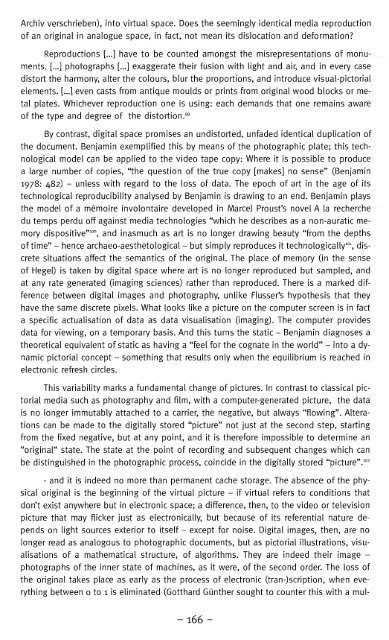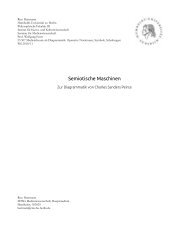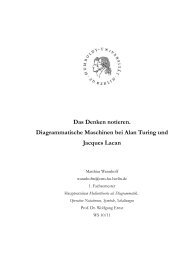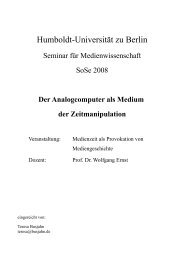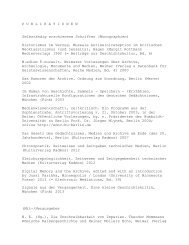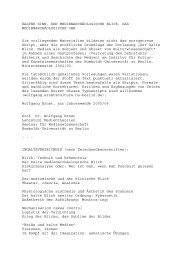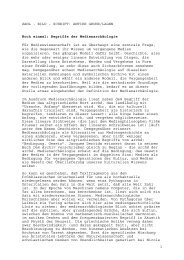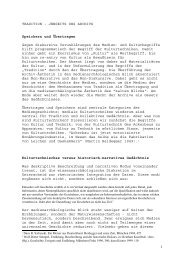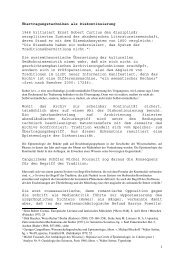Download - Medienwissenschaft
Download - Medienwissenschaft
Download - Medienwissenschaft
Create successful ePaper yourself
Turn your PDF publications into a flip-book with our unique Google optimized e-Paper software.
Archiv verschrieben), into virtual space. Does the seemingly identical media reproduction<br />
of an original in analogue space, in fact, not mean its dislocation and deformation?<br />
Reproductions [...] have to be counted amongst the misrepresentations of monuments.<br />
[...] photographs [...] exaggerate their fusion with light and air, and in every case<br />
distort the harmony, alter the colours, blur the proportions, and introduce visual-pictorial<br />
elements. [...] even casts from antique moulds or prints from original wood blocks or metal<br />
plates. Whichever reproduction one is using: each demands that one remains aware<br />
of the type and degree of the distortion."<br />
By contrast, digital space promises an undistorted, unfaded identical duplication of<br />
the document. Benjamin exemplified this by means of the photographic plate; this technological<br />
model can be applied to the video tape copy: Where it is possible to produce<br />
a large number of copies, "the question of the true copy [makes] no sense" (Benjamin<br />
1978: 482) - unless with regard to the loss of data. The epoch of art in the age of its<br />
technological reproducibility analysed by Benjamin is drawing to an end. Benjamin plays<br />
the model of a memoire involontaire developed in Marcel Proust's novel A la recherche<br />
du temps perdu off against media technologies "which he describes as a non-auratic memory<br />
dispositive" 100 , and inasmuch as art is no longer drawing beauty "from the depths<br />
of time" - hence archaeo-aesthetological - but simply reproduces it technologically 101 , discrete<br />
situations affect the semantics of the original. The place of memory (in the sense<br />
of Hegel) is taken by digital space where art is no longer reproduced but sampled, and<br />
at any rate generated (imaging sciences) rather than reproduced. There is a marked difference<br />
between digital images and photography, unlike Flusser's hypothesis that they<br />
have the same discrete pixels. What looks like a picture on the computer screen is in fact<br />
a specific actualisation of data as data visualisation (imaging). The computer provides<br />
data for viewing, on a temporary basis. And this turns the static - Benjamin diagnoses a<br />
theoretical equivalent of static as having a "feel for the cognate in the world" - into a dynamic<br />
pictorial concept - something that results only when the equilibrium is reached in<br />
electronic refresh circles.<br />
This variability marks a fundamental change of pictures. In contrast to classical pictorial<br />
media such as photography and film, with a computer-generated picture, the data<br />
is no longer immutably attached to a carrier, the negative, but always "flowing". Alterations<br />
can be made to the digitally stored "picture" not just at the second step, starting<br />
from the fixed negative, but at any point, and it is therefore impossible to determine an<br />
"original" state. The state at the point of recording and subsequent changes which can<br />
be distinguished in the photographic process, coincide in the digitally stored "picture". 102<br />
- and it is indeed no more than permanent cache storage. The absence of the physical<br />
original is the beginning of the virtual picture - if virtual refers to conditions that<br />
don't exist anywhere but in electronic space; a difference, then, to the video or television<br />
picture that may flicker just as electronically, but because of its referential nature depends<br />
on light sources exterior to itself - except for noise. Digital images, then, are no<br />
longer read as analogous to photographic documents, but as pictorial illustrations, visualisations<br />
of a mathematical structure, of algorithms. They are indeed their image -<br />
photographs of the inner state of machines, as it were, of the second order. The loss of<br />
the original takes place as early as the process of electronic (tran-)scription, when everything<br />
between 0 to 1 is eliminated (Gotthard Günther sought to counter this with a mul-<br />
-166-


